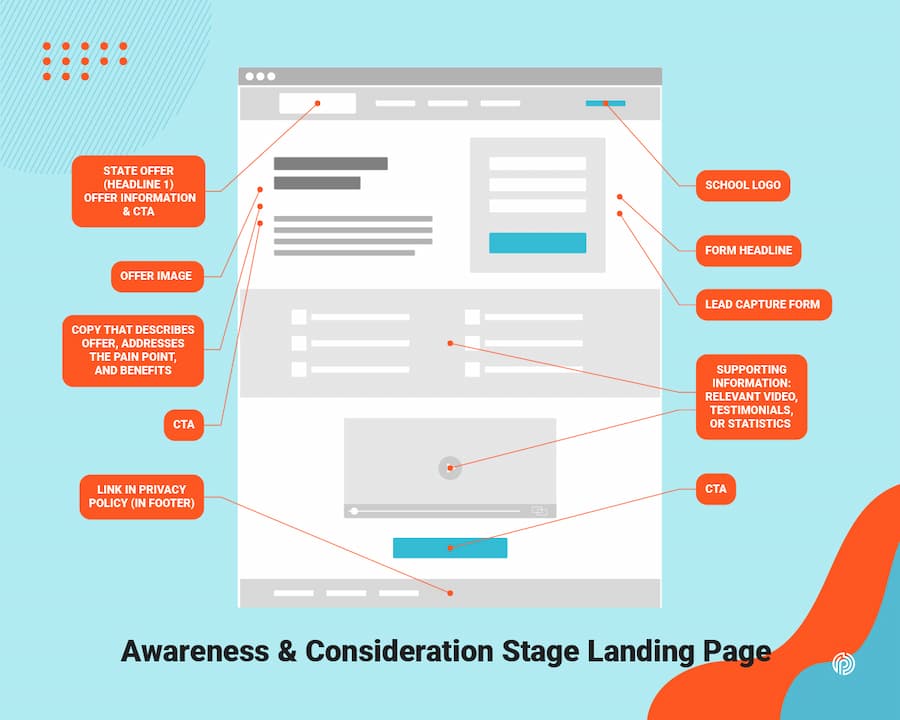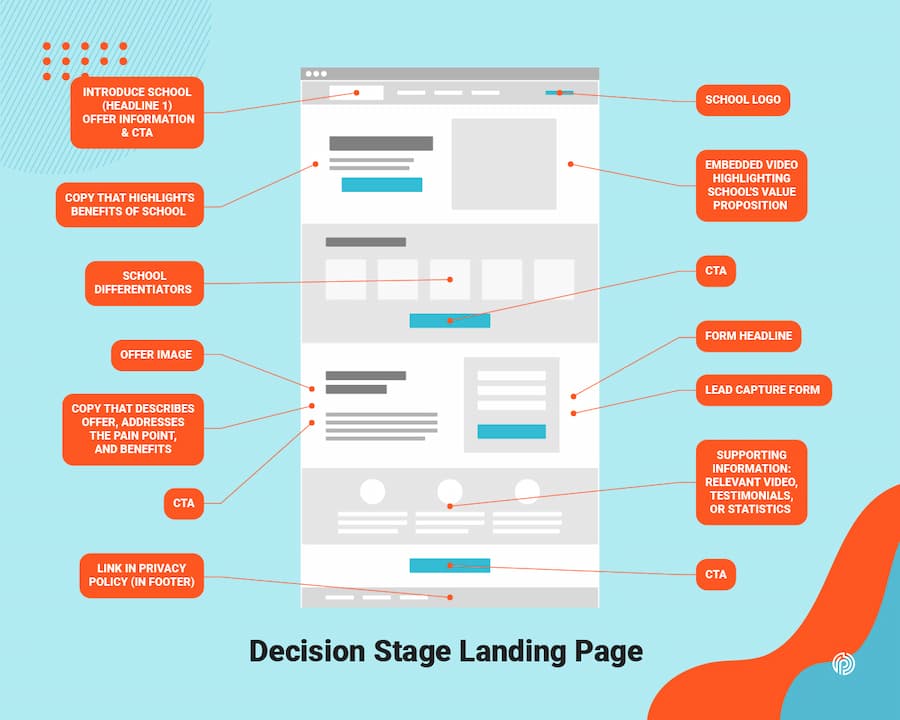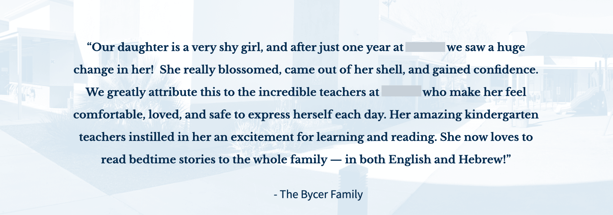Written By:
Eric Bakken
If you’re reading this you may be asking yourself, “Does my school really need landing pages?” The answer is yes! Landing pages are an essential part of every school’s digital marketing strategy. It enables you to promote valuable content to prospective parents and students in exchange for their contact information.
In this blog post, we’ll review elements that make up successful independent school landing pages at every stage of the enrollment funnel.
Whether your current strategy includes paid media channels like Facebook Ads or organic channels like your school’s blog posts, a landing page complements your efforts by providing a conversion point using a relevant offer. Once your prospect requests your offer on a landing page, you’ll be able to add them to a customer relationship management system (CRM) like HubSpot. From there, it’s easy to keep your school top of mind and nurture prospects by sending them emails containing helpful information and offers as they progress through your enrollment funnel!
What do I need to consider when creating landing pages?
No distractions
To help guide prospective parents or students through the process of submitting your form, you’ll want to make sure there are no links to other areas of the site on the page. Removing links and the navigation bar from the page will help more prospects follow through and fill out the lead capture form because you’re limiting the number of paths they can take. While it may feel counterintuitive to restrict where these visitors can go, remember that they have expressed interest in this particular offer and this page’s objective is to provide a simple space for the transaction to take place. If you are using a website builder like HubSpot’s, there may be free landing page templates available to you that already have the navigation bar removed!
Clear, concise headline and subheading
The next items every school landing page needs are a clear and concise headline and subheadline. Now that we’ve removed the navigation, this will be the first item that prospects see when they arrive on your landing page. They will make a choice to stay and read on or leave the landing page based on what your headlines say.
For an awareness or consideration stage offer, you’ll want to use your main headline to state your offer as clearly as possible while grabbing the reader's attention. For decision stage offers, focus on your school in the main headline. Try incorporating your school slogan to make a decision stage headline attention-grabbing!
Use the subheadline to include relevant offer information and a call-to-action. It’s helpful to include the same language used in the ad copy when describing your offer so prospects know they’re on the correct page.

Landing page copy
If your offer falls into the awareness or consideration stage your copy should focus solely on describing your offer and providing additional details. Include additional information about the offer your school is promoting by highlighting the offer’s value proposition. This is your opportunity to explain details such as:
- Who the offer is for
- Why this offer is valuable to your prospect
- What they will receive by submitting the lead capture form

For decision stage offers, you’ll want to break the copy down into three sections: benefits of school, supporting offer information, and testimonials. Start by including information about your school's value proposition. Use this space to highlight the benefits of attending the school, how your school stands out from competitors, and reiterate how your school solves their problem. In the second section, you should include information about the offer and explain what prospects will receive by filling out the form. In the third section at the bottom of the page, you will want to include a testimonial section that contains three positive testimonials from parents, students, and/or alumni.

While drafting the page keep the copy as concise as possible and break the text up by including short sections with key information in bullet points. This will allow important information to stand out and will help prospects see it if they’re skimming the page.

Call-to-action
As you draft your landing page, make sure to encourage prospects to submit your lead capture form throughout the page. This written directive is known as a call-to-action (CTAs). Common places to include CTAs are in the subheadline, in the copy after your value proposition, and at the bottom of the page.
If your website builder has the option, it is helpful to include buttons underneath these CTAs that bring prospects to the form on the page. While creating buttons make sure to be specific about what will happen and what they will receive by clicking the button. Examples of high-performing button copy include: “Download Your Ebook”, “Register For Webinar”, and “Download School Guide”.
Download our free landing page checklist now to create landing pages for your school!
Lead capture form
The lead capture form is the most important element on your school’s landing page. This is where your prospects will provide their information in exchange for your offer. Because this is the main goal of the page and a necessary step in your marketing campaign you’ll want to make sure this is placed in a prominent position next to the offer details on your page. Think about what information you actually need from your prospects at this stage of the enrollment funnel and only include that information in the form fields. While it would be nice to have a lot of information about these prospects, the more fields you require, the less likely they will be to fill the form out. At a minimum, you should at least require their name and email address. Examples of form fields you may want to consider including are:
- First & Last Name
- Email Address
- Phone Number
- Address
- Anticipated Start Year/Grade
- Questions text field (allowing prospects to easily get in touch with your school

Relevant visuals
The next thing to consider is how your landing page looks. Using the same design and color scheme that your school’s website has creates a sense of familiarity. Make sure to include your school’s logo at the top of your landing page to help with this. Another image you should include is an attention-grabbing image showcasing your offer. Examples of this could be an image of your eBook cover or an image of a faculty member speaking during a webinar. This image can be placed near the top of your page or next to your copy.

Relevant video
If possible, embedding a short video on your landing page can help boost the performance of your page. Including a short video can help decrease the bounce rate and improve your engagement rate by offering supporting information in video format. This video should briefly explain your school’s offer and some of the key benefits for awareness and consideration stage offers. For decision stage offers this video should review your school’s value proposition. Some examples of decision stage videos include a message from the principal, mission and vision overview, or relevant admissions video created by students.
End the video by including a CTA encouraging users to submit the lead capture form. You’ll also have the opportunity to set a thumbnail that will attract the attention of prospects and include captions so the video can be enjoyed without the sound!
Social proof
Think back to the last time you purchased something online- did you check the reviews before purchasing? I know I always do! This is because it’s interesting to hear about someone else's experience with a service, especially from those who were once in your position. Adding social proof to your landing page will encourage people to think positively about your school and offer by hearing directly from satisfied parents or students. This leads to more prospects following through with requesting your offer. Some examples of social proof:
- Positive parent, student, or alumni testimonials
- Embedded social media posts
- Number of offer downloads
- Current enrollment numbers

Privacy policy
Anytime you’re collecting information it’s a good idea to include a privacy policy. A privacy policy reassures visitors that you won’t sell their information by quickly explaining how you plan to use the requested information. As a best practice, link to your website’s privacy policy in the footer of the landing page and include a brief privacy policy on the form. The language used could look something like this:
“By requesting information your name will be added to our mailing list to receive email communications from {School Name}. You may unsubscribe from these communications at any time."
Offer delivery
Now that you have your landing page in place, you’ll want to make sure your school is providing your offer or information about your offer in a timely manner. As a best practice, you’ll want to send this follow-up email immediately after the form is submitted. This can easily be accomplished using a customer relationship management system like HubSpot. In HubSpot, you have the option to set up a simple follow-up email that will send when a prospect submits your form. From there, you should also include this contact in a workflow that will send them relevant content and offers as they progress through your enrollment funnel!
Include These Items On Your Landing Pages!
To help you through the process of creating a landing page for your school we’ve created a complimentary checklist! The checklist can be downloaded here and allows you to easily reference these items and keep track of what elements need to be included or updated as you create your landing pages.
If you’re unsure where to start or you’d like to discuss your school’s inbound digital marketing strategy feel free to schedule a free assessment with Pepperland Marketing’s reputable strategists. We are happy to help you identify the best path forward to improve your in-bound enrollment strategy to help you meet your enrollment goals.








